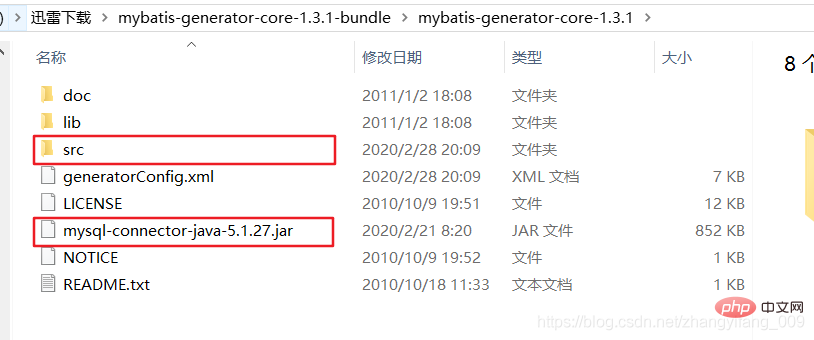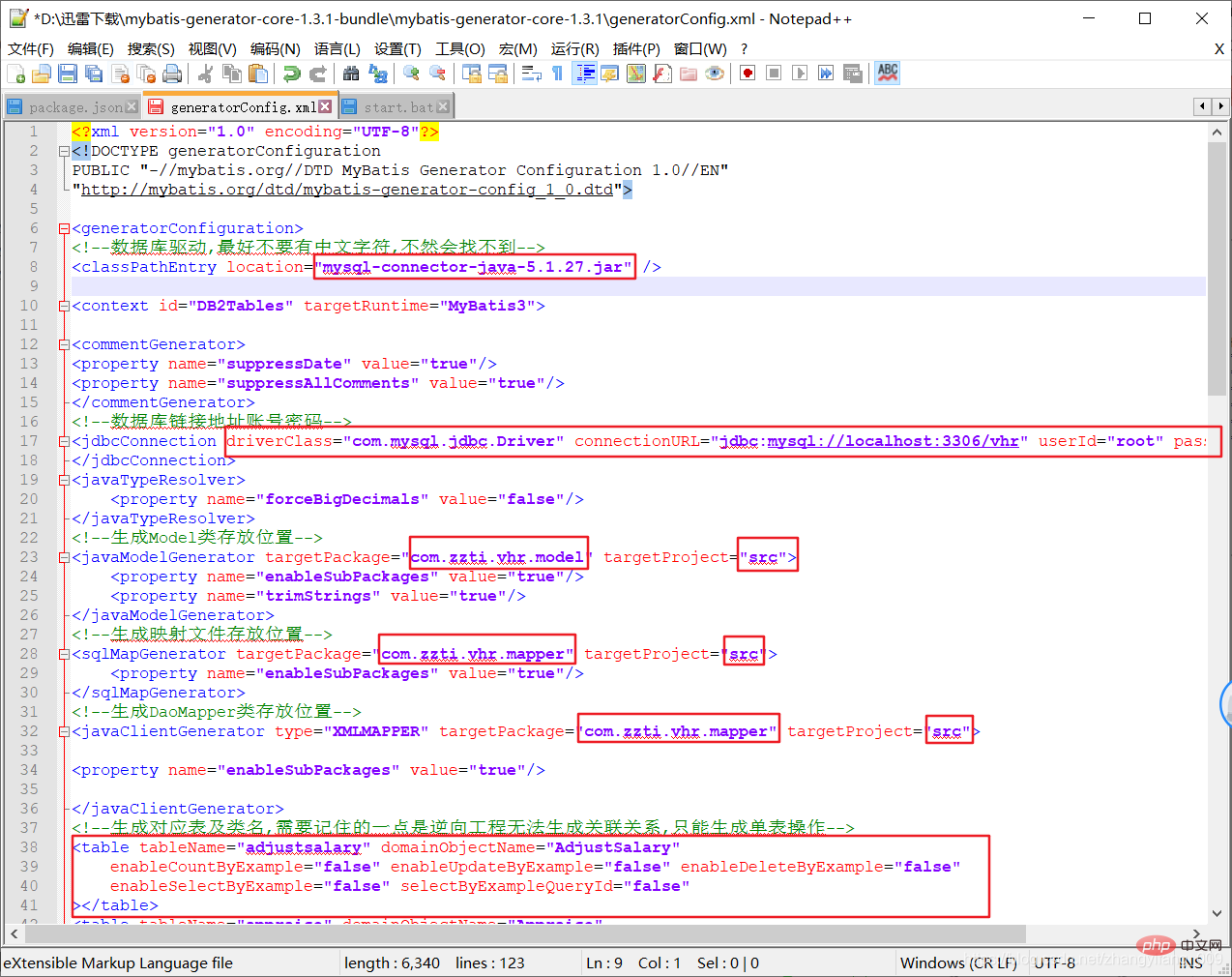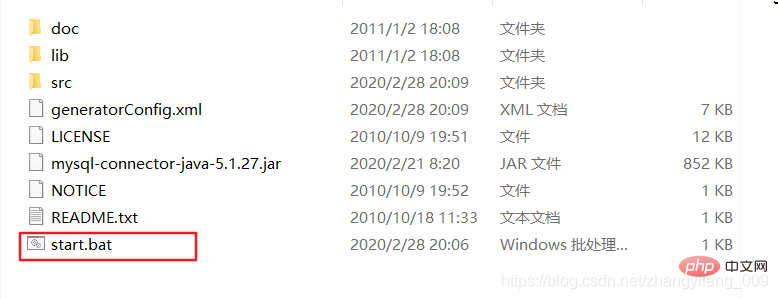 Database
Database
 Mysql Tutorial
Mysql Tutorial
 Let's take a look at the MyBatis command line implementation of reverse engineering
Let's take a look at the MyBatis command line implementation of reverse engineering
Let's take a look at the MyBatis command line implementation of reverse engineering
Free learning recommendation: mysql tutorial(Video)
1. Introduction to MyBatis reverse engineering
During the development process, there are often situations where MyBatis needs to be used. Under normal circumstances, MyBatis construction projects cannot avoid writing entity classes, Dao interfaces, and Mapper mappings. files, these tasks are similar, have a certain degree of repetition, and are sometimes error-prone, so someone invented [MyBatis Reverse Engineering]->MyBatis Generator. MyBatis Generator (MBG) is a code generator that can generate the dao.java, mapper.xml, and pojo entity class files we need. For some projects with many tables, it can reduce a lot of workload and improve our s efficiency. There are many similar tutorials on the Internet. You can install plug-ins in eclipse to generate, and generate in IDEA. Since I use the command line to implement it, I will only introduce the command line method here, which is relatively simple.
The SQL statements that can be generated include:
- insert
- update by primary key
- update by example (using a dynamic where clause)
- delete by primary key
- delete by example (using a dynamic where clause)
- select by primary key
- select by example (using a dynamic where clause) )
- count by example
The variations of these statements depend on the structure of the table (for example, if the table does not have a primary key, MBG will not generate updates through the primary key function) More introductions can Reference documentation: http://mybatis.org/generator.
2. Download the MyBatis Generator file
I downloaded it from github, GitHub address: https://github.com/mybatis /generator/releases, it is recommended to use Thunder to download which should be faster. Download the file and decompress it. The decompressed file directory is as follows: 
Check the contents of the lib folder after decompression. This is the jar package we need to use
3. Configure the generatorConfig.xml file
Create a new generatorConfig.xml file in the folder you just decompressed. Of course, the name of this file is I took it myself, so what does this file do? This configuration file tells MBG:
- How to connect to the database
- What objects are generated, and how to generate them
- What tables should be used for object generation
In addition, we still need to do some preparations:
1) Find the location of the jar package of your database driver. For the convenience of demonstration, I put the database driver under the directory where I just unzipped it. Mine is MySQL5 .7
2) Create a new empty src folder to store the generated files 
generatorConfig.xmlThe content of the file is as follows: 
generatorConfig.xml code
PUBLIC "-//mybatis.org//DTD MyBatis Generator Configuration 1.0//EN" "http://mybatis.org/dtd/mybatis-generator-config_1_0.dtd"><generatorconfiguration><!--数据库驱动,最好不要有中文字符,不然会找不到--><classpathentry></classpathentry><context><commentgenerator><property></property><property></property></commentgenerator><!--数据库链接地址账号密码--><jdbcconnection></jdbcconnection><javatyperesolver> <property></property></javatyperesolver><!--生成Model类存放位置--><javamodelgenerator> <property></property> <property></property></javamodelgenerator><!--生成映射文件存放位置--><sqlmapgenerator> <property></property></sqlmapgenerator><!--生成DaoMapper类存放位置--><javaclientgenerator><property></property></javaclientgenerator><!--生成对应表及类名,需要记住的一点是逆向工程无法生成关联关系,只能生成单表操作--><table enablecountbyexample="false" enableselectbyexample="false"></table></context></generatorconfiguration>
The information that needs to be configured, I have circled it with a red box here, the information that needs to be configured includes
database information;
generated The package name of the entity class and targetProject are the location where our generated file will be stored. I put it in the src directory;
Generate mapper interface information;
Generated mapper xml File information, here my mapper interface and xml file are in the same directory
The database table configuration information to be generated, which tables need to be generated, just add it at the end. The specific meaning of the configuration attributes in the table can be viewed in the document For instructions, refer to here
4. Generate code
The commands that need to be executed on the command line are as follows:
java -jar lib/mybatis-generator-core-1.3.1.jar -configfile generatorConfig.xml -overwrite
We can cd to the current directory and then execute the above command. Here I put it into the bat file to execute, create a new start.bat file, and copy the above command
Double-click to execute the bat file, you can see the generated file in the src directory, and then copy the file we generated to our project to use it!
ps: In the generated file, some fields or methods may not be created correctly. It should be due to the inconsistency between the MySQL environment and the plug-in version. You can try adding the following attributes to jdbcConnection: <property name="databaseSchemaUpdate" value="true"></property>
More related learning recommendations: mysql learning
The above is the detailed content of Let's take a look at the MyBatis command line implementation of reverse engineering. For more information, please follow other related articles on the PHP Chinese website!

Hot AI Tools

Undresser.AI Undress
AI-powered app for creating realistic nude photos

AI Clothes Remover
Online AI tool for removing clothes from photos.

Undress AI Tool
Undress images for free

Clothoff.io
AI clothes remover

Video Face Swap
Swap faces in any video effortlessly with our completely free AI face swap tool!

Hot Article

Hot Tools

Notepad++7.3.1
Easy-to-use and free code editor

SublimeText3 Chinese version
Chinese version, very easy to use

Zend Studio 13.0.1
Powerful PHP integrated development environment

Dreamweaver CS6
Visual web development tools

SublimeText3 Mac version
God-level code editing software (SublimeText3)

Hot Topics
 1652
1652
 14
14
 1412
1412
 52
52
 1303
1303
 25
25
 1250
1250
 29
29
 1224
1224
 24
24
 iBatis vs. MyBatis: Which one is better for you?
Feb 19, 2024 pm 04:38 PM
iBatis vs. MyBatis: Which one is better for you?
Feb 19, 2024 pm 04:38 PM
iBatis vs. MyBatis: Which should you choose? Introduction: With the rapid development of the Java language, many persistence frameworks have emerged. iBatis and MyBatis are two popular persistence frameworks, both of which provide a simple and efficient data access solution. This article will introduce the features and advantages of iBatis and MyBatis, and give some specific code examples to help you choose the appropriate framework. Introduction to iBatis: iBatis is an open source persistence framework
 Comparative analysis of the functions and performance of JPA and MyBatis
Feb 19, 2024 pm 05:43 PM
Comparative analysis of the functions and performance of JPA and MyBatis
Feb 19, 2024 pm 05:43 PM
JPA and MyBatis: Function and Performance Comparative Analysis Introduction: In Java development, the persistence framework plays a very important role. Common persistence frameworks include JPA (JavaPersistenceAPI) and MyBatis. This article will conduct a comparative analysis of the functions and performance of the two frameworks and provide specific code examples. 1. Function comparison: JPA: JPA is part of JavaEE and provides an object-oriented data persistence solution. It is passed annotation or X
 Detailed explanation of the Set tag function in MyBatis dynamic SQL tags
Feb 26, 2024 pm 07:48 PM
Detailed explanation of the Set tag function in MyBatis dynamic SQL tags
Feb 26, 2024 pm 07:48 PM
Interpretation of MyBatis dynamic SQL tags: Detailed explanation of Set tag usage MyBatis is an excellent persistence layer framework. It provides a wealth of dynamic SQL tags and can flexibly construct database operation statements. Among them, the Set tag is used to generate the SET clause in the UPDATE statement, which is very commonly used in update operations. This article will explain in detail the usage of the Set tag in MyBatis and demonstrate its functionality through specific code examples. What is Set tag Set tag is used in MyBati
 Various ways to implement batch deletion operations in MyBatis
Feb 19, 2024 pm 07:31 PM
Various ways to implement batch deletion operations in MyBatis
Feb 19, 2024 pm 07:31 PM
Several ways to implement batch deletion statements in MyBatis require specific code examples. In recent years, due to the increasing amount of data, batch operations have become an important part of database operations. In actual development, we often need to delete records in the database in batches. This article will focus on several ways to implement batch delete statements in MyBatis and provide corresponding code examples. Use the foreach tag to implement batch deletion. MyBatis provides the foreach tag, which can easily traverse a set.
 Detailed explanation of how to use MyBatis batch delete statements
Feb 20, 2024 am 08:31 AM
Detailed explanation of how to use MyBatis batch delete statements
Feb 20, 2024 am 08:31 AM
Detailed explanation of how to use MyBatis batch delete statements requires specific code examples. Introduction: MyBatis is an excellent persistence layer framework that provides rich SQL operation functions. In actual project development, we often encounter situations where data needs to be deleted in batches. This article will introduce in detail how to use MyBatis batch delete statements, and attach specific code examples. Usage scenario: When deleting a large amount of data in the database, it is inefficient to execute the delete statements one by one. At this point, you can use the batch deletion function of MyBatis
 Detailed explanation of MyBatis cache mechanism: understand the cache storage principle in one article
Feb 23, 2024 pm 04:09 PM
Detailed explanation of MyBatis cache mechanism: understand the cache storage principle in one article
Feb 23, 2024 pm 04:09 PM
Detailed explanation of MyBatis caching mechanism: One article to understand the principle of cache storage Introduction When using MyBatis for database access, caching is a very important mechanism, which can effectively reduce access to the database and improve system performance. This article will introduce the caching mechanism of MyBatis in detail, including cache classification, storage principles and specific code examples. 1. Cache classification MyBatis cache is mainly divided into two types: first-level cache and second-level cache. The first-level cache is a SqlSession-level cache. When
 Detailed explanation of MyBatis first-level cache: How to improve data access efficiency?
Feb 23, 2024 pm 08:13 PM
Detailed explanation of MyBatis first-level cache: How to improve data access efficiency?
Feb 23, 2024 pm 08:13 PM
Detailed explanation of MyBatis first-level cache: How to improve data access efficiency? During the development process, efficient data access has always been one of the focuses of programmers. For persistence layer frameworks like MyBatis, caching is one of the key methods to improve data access efficiency. MyBatis provides two caching mechanisms: first-level cache and second-level cache. The first-level cache is enabled by default. This article will introduce the mechanism of MyBatis first-level cache in detail and provide specific code examples to help readers better understand
 In-depth understanding of the batch Insert implementation principle in MyBatis
Feb 21, 2024 pm 04:42 PM
In-depth understanding of the batch Insert implementation principle in MyBatis
Feb 21, 2024 pm 04:42 PM
MyBatis is a popular Java persistence layer framework that is widely used in various Java projects. Among them, batch insertion is a common operation that can effectively improve the performance of database operations. This article will deeply explore the implementation principle of batch Insert in MyBatis, and analyze it in detail with specific code examples. Batch Insert in MyBatis In MyBatis, batch Insert operations are usually implemented using dynamic SQL. By constructing a line S containing multiple inserted values




